Make your drummet large and weight the bottom with a couple of heavy stones, also use a large-size mesh so that small fish can swim out freely. A drummet is an ideal way to ensure a regular supply of fresh fish.
SNARE FOR LOBSTERS OR YABBIES
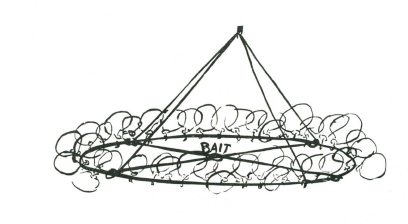
A circle of heavy gauge wire (8 g.) is made. The circle should be from 12” to 15” across. To support its shape two cross wires are secured.
Around the circle of wire a series of running nooses are tied. The noose need be no more than 2 inches across. Heavy nylon fishing line is excellent for this. These nooses should be about 1” to 1½” apart around the circle.
The bait is tied in the centre where the supporting cross wires pass each other.
Three or four cords tied to the circle are joined to a central rope which is buoyed to mark its position.
This is an excellent lobster snare.
HOLLOW LOG TRAP FOR FRESH WATER FISH
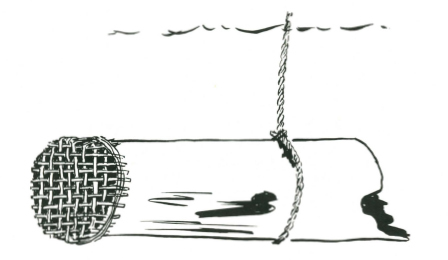
The fact that fish cannot swim backwards is made use of in this hollow log trap. A hollow log, not too large in diameter is covered at one end with a piece of wire netting or other material which will allow a free flow of water. A sling is made in such a manner that when the rope is pulled to lift the trap to the surface it will tilt the hollow log so that the wired-in end is lowest. The bait is put in a few inches from this closed end and the trap lowered into a convenient pool or off a rock ledge.
The fish swimming about in the stream will scent the bait, and eventually find their way into the hollow log by means of the open end. If the hollow in the log is not too large the fish will be unable to turn around to swim out, and as a result will be trapped in the hollow. The open end of the hollow log should always be upstream, otherwise the current may wash the fish free.
A similar method of catching smaller fish is possible with an open-necked pickle bottle. The bait, such as a piece of dough, or other food, is stuck at the lower end of the bottle. The bottle is placed in shallow water, taking care to see that all air is first removed before setting the bottle in position. Small fish such as sand mullet, whiting, etc., will swim into the bottle, and cannot return. This is a good way to catch small fish for bait.
LOBSTED OR CRAYPOT
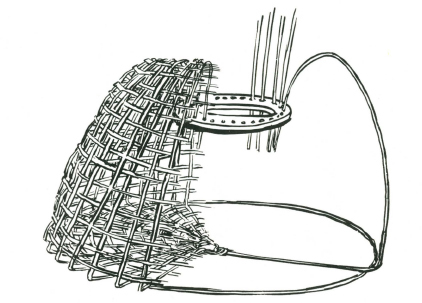
A board about one foot square, by one inch thick, has a circle drawn on one side. The diameter of the circle is about eight inches. Quarter-inch holes are bored around the circle. These holes are about an inch apart. Five-foot lengths of cane are put into each of these holes, and about three or four inches above the board start weaving split cane, so that the shape is like a wide funnel. The upright canes are gradually bent further and further with this weaving till they come right over and down, when the whole working is turned upside down for greater convenience. At the base, which should be about two feet from the top and about three feet across the circle, turn the canes sharply in to the centre of the circle. This, when the lobster pot is turned right way up in the water, is the bottom of the trap.
Weight the bottom with a heavy stone, and bait with old fish heads or other fish bait, and lower the lobster pot into a rocky weedy position. Lobsters live in caves in the rocks, and generally in colonies. The hoisting rope for the pot must be buoyed with a marker so that you can find it again. The pot may take a few days to ‘weather’ after you have first made it. Several such pots will secure you a fair supply of lobsters or crayfish.
IMPROVISED FISH-HOOK MADE FROM THORNS
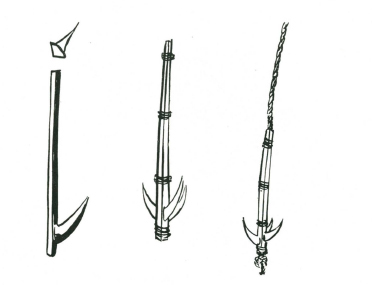
Three long and strong thorns are cut with about two inches of wood left above the upward curve of the thorn, and about a quarter inch below the end of the wood of the thorn. Make sure the thorns are long, hard and sharp. The wood section is pared down with a sharp knife so that the angle is about 120 degrees. If this is done correctly the three pieces of wood with the thorns can be fitted together to make a three-pronged hook. The wood is strongly bound with tough fibre thread at least twice on the shank, and once below. If possible it is advisable to bring the line, or at least a short length (for a cast) down the centre where the three pieces of wood join. This cast should be finished off with a thumb knot at the butt of the hook so that it cannot be pulled through.
Such hooks as this are quite as efficient as the steel hook, and can be easily made by anyone with careful fingers.
FISHING SPEARS
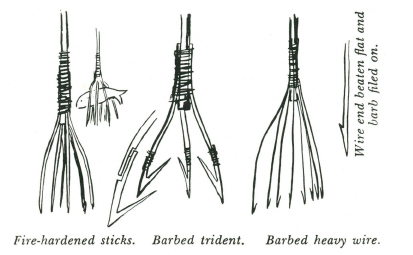
Fire-hardened sticks. Barbed trident. Barbed heavy wire.
The best spearing is over shallow sandy shallows at night with an acetylene torch or very powerful five or six cell electric torch. With fish spearing the aim is to pin the fish down with the spear rather than thrust at the fish. Move the spear slowly till it is over the fish and then jab suddenly in the strike. Fish spearing by day can be either done from a boat or raft or coracle, or from a rocky ledge. In any case you will need a sea glass or underwater goggles so that you can see clearly without any interruption by surface ripple. A sea glass can be made by cutting the bottom out of a tin and simply looking through the hole the tin provides. This will protect the water within the tin from surface ripple. Or, better still, you can put a glass bottom to the tin and secure it with sticking plaster or scotch tape. When fishing from a boat, spear as nearly vertical as possible. In spearing for fish move slowly and quietly, and allow for the angle of distortion of the water. Remember that fish have a natural protective colouring and at first they will be difficult to see. They are easiest to detect when they move, or by their shadow against the sea bottom. Fish spears should be multi-pronged for greater efficiency, and, if made of wire are more certain if barbed.
STICK SNARE FOR SURFACE FEEDING FISH

Surface feeding fish may be snared by means of a noose set on the underside of a weighted stick. The stick should be ten to twelve inches long, and on one side a small chip of stone is secured, either by tying or by slightly splitting the stick and driving the chip of stone into the split. A noose of gut, horsehair, or other thin material is tied so that the noose is on the same side as the stone chip. A number of these noose sticks are made and thrown into the sea from a rocky promontory. Surface feeding fish such as Long Toms and Garfish take cover beneath any debris floating on the surface of the sea. This is their protection against sea birds from above, and other bigger fish from deeper water. They will hide under the noose sticks, and in time either their bills or tails will become caught in the noose. Their struggles against the noose tire them out, and the wash of the surf takes them in to the beach. A couple of hours after you have thrown the noose sticks into the sea they will have drifted in to the wash at the beach and you can recover the sticks and any fish which have become snared in the nooses.
BAITED FLOAT STICK

An effective method of fishing with float sticks in fairly calm water or off beaches where there is a set inshore to the beach is possible by constructing a number of ‘float sticks’ to which a stout short length of fishing line is attached, with either a baited hook or a boomerang-shaped piece of bone or shell baited as for a hook. These float sticks are made about two feet long, and on one end a fairly heavy stone is attached by means of a couple of straps of bark strips of cane enclosing the stone, and bound to the stick. This weight will make the stick stand upright in the water. To the top end of the stick the line is attached, and this should be about two to three yards in length. The farthest end of the cord carries the baited hook or piece of bone. These sticks are thrown into the water and allowed to drift. The fish taking the bait is hooked either by the hook or by the boomerang, and struggling against the drag of the bait stick, exhausts itself so that the drift or current takes it in its course. It is necessary if you are using this method of fishing to watch the direction of drift or current and know whereabouts to look for the sticks some hours after you have cast them into the water.